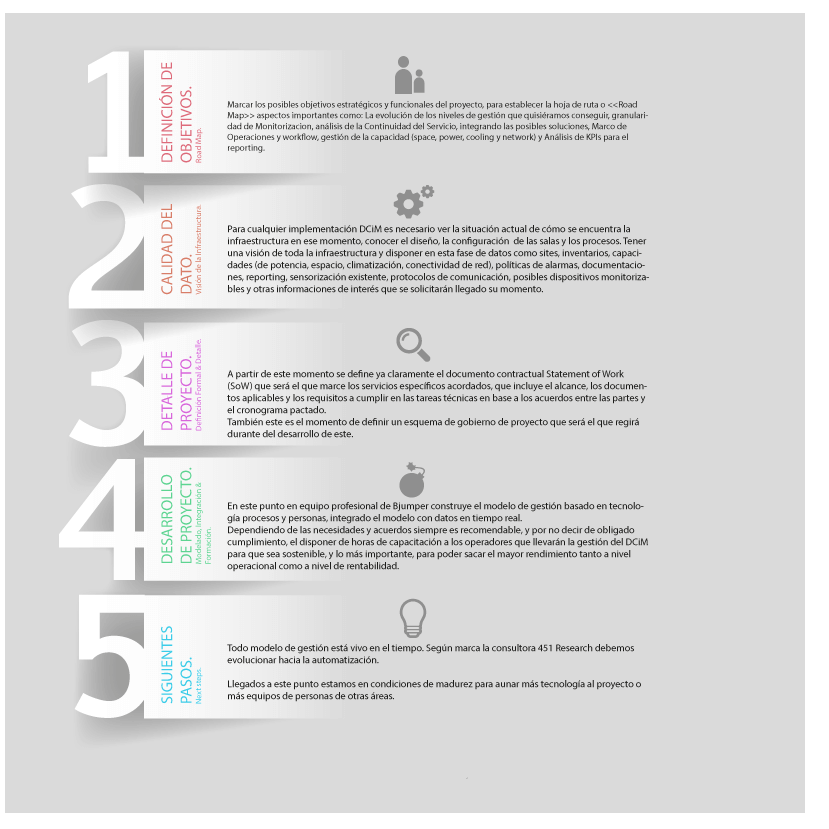Globalization and technological advances are making Data Centers incorporate DCIM tools into the management of their critical infrastructure as the basis for process automation.
The integration of new technologies, company acquisitions, and global market competitiveness are increasingly complicating the management of these infrastructures as they face a growing volume of data and a wide variety of devices.
These reasons are more than sufficient to consider the implementation of a DCIM tool in these infrastructures as obligatory and necessary. It aims to integrate everything under a single management and monitoring tool, regardless of location or the management and control tools currently in use. The primary goal is to shift to a management model based on DCIM to implement proactive policies in critical infrastructure management.
In many cases, managers may want to implement these tools but are aware of the potential risks, especially at critical points during the implementation process. This should not be a barrier. On the contrary, identifying risks means being able to address them in a timely manner.
At Bjumper, we want to reassure all those responsible for infrastructure and operations by conveying that implementing DCIM is not as costly, complex, or risky as it may seem when done appropriately and through specialized companies. Specific knowledge is the key to success.
It's not enough to have expertise in IT, electromechanics, communications, security, etc., and purchase licenses. A proper and personalized roadmap must be created for each project, outlining each objective and the steps to be taken at each moment. Before launching anything, it's essential to have a clear understanding of the current infrastructure's status and where you want to position it. Managing expectations and breaking down projects allow us to see the benefits in a short time with appropriate investments.
In these processes, we must acknowledge that we haven't invented a new working methodology but rather build upon existing ones in the market. This ranges from ITIL and SCRUM to best practices dictated by logic. Each implementation for Bjumper is treated as a PROJECT, and as such, it is approached with a Statement of Work (SoW), risk matrices, governance models, all oriented toward project success
Here are the key points in the implementation of a project:

For any DCIM implementation, it is necessary to assess the current state of the infrastructure at that moment, including understanding the modeling, room configurations, and current processes. Having a clear view of the entire infrastructure is crucial at this stage, and you should have data such as site information, inventories, capacities (power, space, cooling, network connectivity), alarm policies, documentation, reporting, existing sensor information, communication protocols, potential monitorable devices, and other relevant information that may be requested at a later stage. With all the collected information, you can gain a clear understanding of how the infrastructure operates and identify potential areas for improvement.
Now is the time to define the possible strategic objectives of the project. In this part of the road map, you would focus on issues such as:
The evolution of the levels of management and automation you aim to achieve.
The granularity of IT monitoring.
Service Continuity management, including integrating available solutions, proposing new alarm systems, work orders, etc.
Capacity management (Power, space, Network, Cooling), the infrastructure's lifespan.
Efficiency: Key Performance Indicators (KPIs), customized and device-specific reporting (e.g., PUE), dashboards
Once you have a good understanding of the infrastructure and the strategic objectives you want to achieve, you can continue with the Road Map. Here, you'll work on the functional objectives defined among all parties, with a clear definition of the actions to be taken and the benefits and objectives achieved for each of them.
From this point on, the SoW document is clearly defined, outlining the specific services agreed upon, including scope, applicable documents, and technical task requirements based on agreements between the parties and the agreed-upon schedule.
Lastly, depending on the needs and agreements, it is always recommended, if not mandatory, to provide training hours for the technicians responsible for DCIM management. This ensures sustainability and, most importantly, maximizes operational efficiency and profitability.
